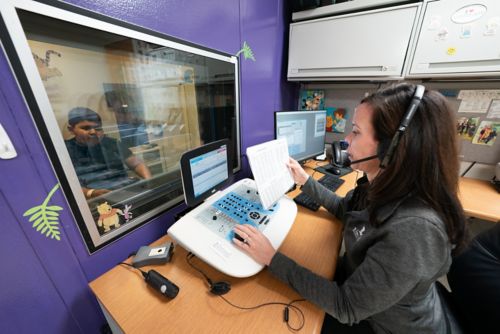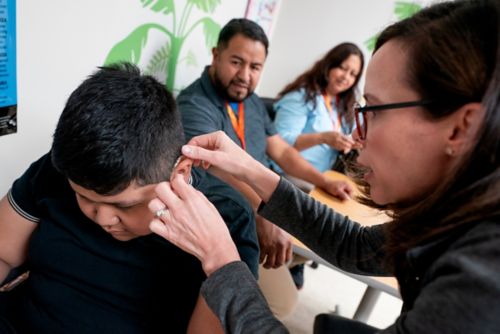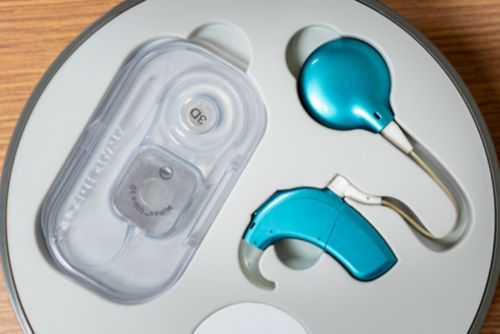St. Jude Family of Websites
Explore our cutting edge research, world-class patient care, career opportunities and more.
St. Jude Children's Research Hospital Home

- Fundraising
St. Jude Family of Websites
Explore our cutting edge research, world-class patient care, career opportunities and more.
St. Jude Children's Research Hospital Home

- Fundraising
Giving survivors of childhood cancer a chance at hearing

St. Jude patient Eli Castellon attends an appointment to assess his hearing.
When a child receives cancer treatment, patients and families often expect side effects such as hair loss and fatigue, but many may be surprised by treatment-associated hearing loss. Hearing loss is a significant side effect of certain high-dose chemotherapy regimens, particularly those containing platinum-based drugs – such as cisplatin – as well as some radiation therapies. Auditory assistance devices, which include hearing aids and cochlear implants, have the potential to greatly improve people’s lives by amplifying the world of sound. But for childhood cancer survivors, accessing cochlear implants has been a historically fraught experience that, due to a combination of guidance changes and technological innovations, may now be changing.
Johnnie Bass, AuD, PhD, St. Jude Rehabilitation Services, researches how hearing loss affects survivors and how to address it best. Published in a letter to JAMA Oncology, Bass documented survivors’ biggest risks for hearing loss and whether they qualified for cochlear implantation evaluation. The guidelines for who qualifies for such evaluations recently expanded access, so Bass studied how that may offer new opportunities to survivors.
“Our findings indicate a high prevalence of survivors with severe to profound hearing loss who may benefit from a referral for cochlear implant candidacy evaluation,” Bass said. “We were a little surprised by how many survivors, over 60%, actually now qualified for a referral.”

Eli is fitted for new hearing aids by Johnnie Bass, AuD, PhD, St. Jude Rehabilitation Services, while his family watches.
Helping survivors understand their hearing aid options
Among a group of 376 participating survivors from the St. Jude After Completion of Therapy (ACT) Clinic or St. Jude Lifetime Cohort Study (St. Jude LIFE), 61% experienced severe-enough sensorineural hearing loss to qualify for a cochlear implant evaluation, as measured by an objective hearing assessment. Cochlear implantation is a surgery that patients qualify for through an assessment consisting of standardized tests that evaluate how well they can hear and understand speech. A less invasive hearing loss intervention is the basic hearing aid, but hearing aids often cannot provide adequate benefit for people with severe to profound hearing loss. Bass found that many survivors with severe to profound hearing loss do not use them.
“Over 40% of survivors who met the cochlear implant candidacy criteria did not use hearing aids, which is surprising given the severity of their hearing loss,” Bass said. “The number one reason people don't use hearing aids is a lack of perceived benefit, which may have contributed to low hearing aid use in survivors in our study given their severity of hearing loss.”

A modern cochlear implant, which even survivors who require regular MRIs can have.
Survivors may not believe any hearing interventions can help them because they did not find basic hearing aids useful. But cochlear implants work differently. A cochlear implant has two main parts: an external device worn behind the ear and an internal device placed inside the cochlea (a part of the inner ear) during surgery. A magnet holds the two parts together. The internal device directly stimulates the auditory nerve, bypassing damaged areas of the inner ear to send messages to the brain. Cochlear implants may work when hearing aids do not, giving these survivors a chance to improve their hearing.
“We need to get that message of potential benefit out to survivors so they realize that hearing aids or cochlear implantation could drastically improve their lives, and they should get tested,” Bass said.
Technological advancements and expansion of candidacy criteria create new priorities
Historically, access to hearing assistance devices that cannot be removed, including cochlear implants, has been limited for survivors. After their initial treatment, most survivors need years of follow-up magnetic resonance imaging (MRI) scans. Because MRIs are big magnets, scans were incompatible with patients having a magnet or small electronic devices that contain metal in their ears. But in recent years new hearing technologies have emerged to improve implants, enabling survivors to safely receive scans and still address their auditory issues.
Bass was partially motivated by these new technological advances, in addition to expanded candidacy criteria. She wanted to assess the prevalence of survivors who could now be candidates for cochlear implantation, along with the treatment-related risk factors that could predict who would be the most likely to qualify.
“Our work supports the conclusion that higher cumulative cisplatin, a platinum-containing drug, and cochlear radiation doses are associated with more severe hearing loss,” Bass said. “Knowing those patients are at increased risk of hearing loss, we can prioritize referrals for cochlear implant candidacy evaluation for them, getting them the help they may need as early as possible.”
In the future, better hearing-loss screening and interventions may play a role in significantly improving survivors’ quality of life. “We’ve already implanted a few of these devices in patients at St. Jude,” Bass said. “Clinically, we have seen lives changed. The improvement in their audibility has had dramatic and meaningful impacts on their social and emotional well-being.”






